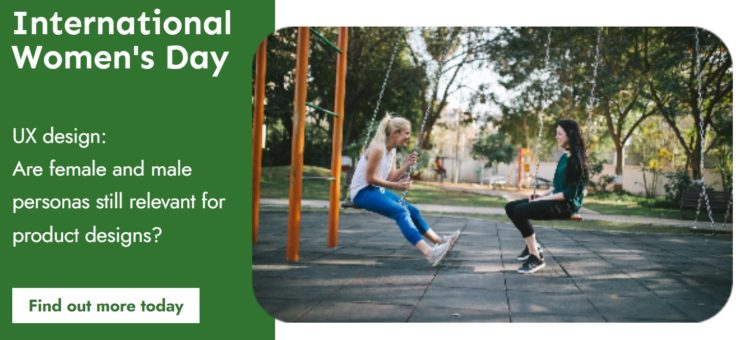Product design, user experience and gender equality – can it work?
8 March 2023
The theme for International Women’s Day this year focusses on gender equality. We want to take a look at how user experience design can play an important role in making sure products are designed with gender equality in mind.
To create a user-centered design you need to understand the user, including their requirements for the product, their limitations, their preferences and their instinctive interaction with the product. All of these can be quite different for the different genders. So can you make a product equally suitable for both?
Sometimes it isn’t technically feasible to make one design to cover both, for example when male and female anthropometrics are too diverse. In many industries, male and female models commonly exist. An example may be sports equipment like bikes or even snowboards. This is likely also driven by a commercial decision: the additional market share that can be won justifies the cost of multiple related products. But what about the products where one gender is considered to be in the minority for the target user group? An example of this may be personal protective equipment for the building industry or car safety. Is it acceptable to make the commercial decision not to include these users?
When designing new products, we also need to consider the physiological, or biological, differences associated with gender, and sociological or behavioural differences.
The physiological differences
The physiological differences associated with gender includes fairly straightforward discrepancies such as the difference in the angles of the pelvis in male and female skeletons. This means, for example, the optimum alignment for waist straps on hiking rucksacks and safety belts in cars are different for male versus female bodies. In the case of ruck sacks, this just leads to more uncomfortable rucksacks for women.
For car safety belts, the design assumes a male-bodied user, and lays the seatbelt waist strap flat across the front of his pelvis. In a crash, the waist strap spreads pressure evenly across his pelvis, directing the impact into strong bones better able to survive the forces involved. However, when the same waist strap tries to catch a female-bodied user, her typically wider, more angled pelvis cannot catch the waist strap, which rides up, directing the force of the crash into her abdomen and spine 1 . These differences in safety belt behaviour are likely part of why the likelihood of injury in a given car crash is so much higher for women than men2, and why the injury patterns also vary by sex.
Behavioural differences
Sociological or behavioural differences associated with gender aren’t necessarily innate; they can vary significantly between countries or social groups, but they are surprisingly rigid and should be considered in design. A useful example is playgrounds and public parks- many local authorities want to encourage young people to exercise more and spend more time outside, so they provide parks and playgrounds for them, but particularly among teenage girls activity and exercise levels are still worryingly low. When Make Space for Girls, a campaign group pushing for more equality in shared spaces, investigated this, they found that public parks were often dominated by- and designed for- groups of young men and boys3. Local authorities often build skate parks and Mixed Use Games Areas (MUGAs) to provide spaces for young people. When Make Space for Girls asked young women whether they used these spaces, they said no. The young women highlighted design issues like a lack of lighting, the importance of having multiple exits and entrances to spaces, the way they would not go into enclosed spaces (like MUGAs) when boys or men were using them4. Design features that appeal to young women are very different to these – they like seating options that allow face-to-face conversation, path routes that break up spaces to prevent single groups dominating large areas and provide “passive supervision” from passers-by, and they like variation in height. Many of the young women surveyed like swings and being able to perch up high. Most notably, many of the young women surveyed could tell the design process had ignored them- they felt many public spaces were “not for them” or “not intended for us”. Taking these considerations into account in design will increase female participation in and access to public spaces and public life – Make Space for Girls has several case studies of successful public space designs that considered young women users in the design itself5.
These differences create surprising user behaviours- for example, the British Army’s Virtus daysack was designed to spread load using a wire frame, intending to solve poor weight distribution (a problem specifically flagged by female soldiers). However, the wire frame wasn’t designed to accommodate female body shapes, resulting in female soldiers adapting the daysack to make it usable- by ripping out the wire frame entirely6.
At the very least, should the user be informed about the potential risks of using a product that is not designed for their gender? Should this be regulated? And if so, could this requirement to inform the public be a positive motivator for companies to invest in gender inclusion?
Ideally of course, a design can cater for both genders. And this will in many cases be possible. But requires the awareness, the insight, and the creativity early on in the design phase. All of which Springboard can help you with.
1 Invisible Women: extremely tiny men (carolinecriadoperez.com)
2 Original research: Sex-disaggregated analysis of the injury patterns, outcome data and trapped status of major trauma patients injured in motor vehicle collisions: a prespecified analysis of the UK trauma registry (TARN) – PMC (nih.gov)
3 https://www.makespaceforgirls.co.uk/blog/the-territories-of-skate-parks
4 https://www.youtube.com/watch?v=DGY0arU-U2U&t=2s
5 https://www.makespaceforgirls.co.uk/case-studies/umea
6 https://newsletter.carolinecriadoperez.com/p/invisible-women-issue-4-unisex-genitals?


